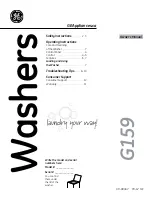
C
o
n
su
m
e
r
S
u
p
p
o
rt
T
ro
u
b
le
sh
o
o
tin
g
T
ip
s
O
p
e
ra
tin
g
In
st
ru
c
tio
n
s
S
a
fe
ty
In
st
ru
c
tio
n
s
Before you call for service…
Troubleshooting Tips
Save time and money! Review the charts on the following pages, or visit
GEAppliances.com.
In Canada visit
www.GEAppliances.ca
. You may not need to call for service.
Error Messages
Possible Causes
What To Do
START/RESET status
You have pressed the
•
Press the
START/RESET
pad once to start the dishwasher. Press the
indicator light flashing START/RESET
pad while the
START/RESET
pad a second time when the dishwasher is running only if you
dishwasher is running. This will
wish to cancel the cycle.
cancel the cycle. The light will
stop flashing after the dishwasher
drains (about 90 seconds).
Power to the dishwasher was
•
The light will stop flashing after the dishwasher drains. A new cycle will
turned off while a cycle was
start automatically.
running and power has just been
restored to the dishwasher. The
blinking lights indicate that the
dishwasher is draining the potential
water inside.
Dishwasher BEEPS
This is a reminder that your
•
Close and latch the door after opening it mid-cycle.
once every 30 seconds
dishwasher door has been left
open during operation. It will
continue beeping until you close
the door.
Beeping at the end
This is normal. The dishwasher •
To turn off the double beep indicator (or re-activate it if it was previously
of the cycle
will beep twice at the end of the
turned off), press the
HEATED DRY
pad 5 times within 3 seconds.
cycle
A triple beep will sound to indicate the end-of-cycle beep option
has been turned on or off.
Low Detergent light
SmartDispense
™
has less than
•
Fill the SmartDispense
™
reservoir with liquid detergent. After filling the
is ON
10 cycles worth of detergent
reservoir, the
LOW DETERGENT
light will turn OFF once the door is closed.
left in the dishwasher
If you are not using the SmartDispense
™
feature, turn off the low detergent
light by pressing the
ADDED HEAT
pad 5 times within 3 seconds.
Problem
Possible Causes
What To Do
Dishes and flatware
Low inlet water temperature
•
Make sure inlet water temperature is correct (see page 12). Turn on the hot
not clean
water faucet nearest the dishwasher, let run until the water temperature
stops rising. Then start the dishwasher and turn off the faucet. This insures
the entering water is hot.
Water pressure is temporarily low •
Turn on a faucet. Is water coming out more slowly than usual? If so, wait
until pressure is normal before using your dishwasher.
Air gap or disposer is clogged
•
Clean the air gap or flush the disposer.
Improper rack loading
•
Make sure large dishware does not block the detergent dispenser or the
wash arms. See the
Loading the dishwasher racks
section.
No air gap or high drain loop
•
Verify that you have an air gap or a high drain loop. Refer to the
Installation Instructions.
Spots and filming
•
Use rinse agents such as
Cascade Crystal Clear
®
to remove spots
on glasses and
and prevent new film buildup.
flatware
•
Make sure water temperature is at least 120°F.
•
Load dishwasher as shown in the
Loading Place Settings
section.
•
Make sure detergent is fresh.
•
If water is extremely hard, a softener may be required.
Cloudiness on
Combination of soft water and
•
This is called
etching
and is permanent. To prevent this from happening,
glassware
too much detergent
use less detergent if you have soft water. Wash glassware in the shortest
cycle that will get it clean. Recalibrate the SmartDispense
™
system if you
are using it (see page 15). Do not use the manual detergent dispenser and
the SmartDispense
™
at the same time.
Water temperature entering the •
This could be etching. Lower the water heater temperature.
dishwasher exceeds 150°F (66°C)
Extremely hard water
Low inlet water temperature
Overloading the dishwasher
Improper loading
Old or damp powder detergent
Rinse agent dispenser empty
Too little detergent
19
















































